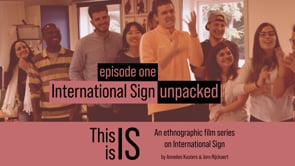What is International Sign ? Explore the answer by joining a group of deaf youth from across the globe, as they embark on a life-changing journey to Denmark to participate in the "Frontrunners" educational program. From South Korea and Jordan to Brazil and the USA, these young adults bring with them unique experiences and varying fluencies in IS, creating a truly diverse and dynamic group. The film captures the fascinating process of students and teachers "calibrating" their signing to communicate effectively, forging meaningful connections and striving towards a shared understanding of what "International Sign" should look like. Through a blend of techniques, "International Sign Unpacked" explores the evolution of sign language usage and the inequalities that exist within this process, offering a captivating look at how International Sign communication evolves within a small group after its frequent use.
Can a mix of sign languages be classified as International Sign? At DOOR International Africa, a multilingual campus in Nairobi, passionate teams from Mozambique, South Sudan, and Kenya are working tirelessly to translate the Bible into their national sign languages. The teams tackle the dual challenge of a lack of resources in national sign languages and the historical use of American Sign Language in Africa. In this unique multilingual environment, a fascinating mix of sign languages emerges, including Kenyan Sign Language, other African sign languages, American Sign Language, and Indian Sign Language. As campus residents socialize across countries, the question arises: Can this hybrid be considered International Sign?
Can International Sign be learned in a short span of time? Find out in "International Sign crash course", where we attend SIGN8, an international sign language research conference in Brazil. With no interpreters present, participants must quickly learn International Sign (IS) and Brazilian Sign Language (Libras) to communicate effectively. The episode captures the dynamic mix of IS and Libras in presentations and conversations, where participants learn from each other. From pre-conference workshops to engaging in conversations, the learning never stops. Lack of interpreters presents challenges for some, but accelerates the learning process for others. This episode also offers insights from deaf linguists on the influences between different sign languages and the unique aspects of IS as a deaf phenomenon.
Is International Sign (IS) more visually expressive than other forms of signing? Explore the answer at the Clin d'Oeil festival in Reims, where international deaf performance art takes center stage. From theatre and comedy to magic, music, and street performances, the festival showcases acts exploring a range of human interest themes. Through interviews with performers, the film offers fascinating insight into sign language translation, with artists translating their plays from national sign languages into IS. Meanwhile, a comedian tries to incorporate signs from the audience into his act, and a musician offers a unique perspective on not performing his songs in IS. The film moves on to explore physical theatre, gestures that hearing people can understand, and VV (visual vernacular), leaving audiences questioning whether IS truly is the most visual way of signing and if it can capture the raw emotion of acting from "the gut.”
Can International Sign (IS) truly be a one-size-fits-all solution, creating an ideal conference language where diverse national sign languages and interpreters coexist? "One size fits all?" delves into the world of IS interpreting, sharing insights from the World Association of Sign Language Interpreters (WASLI) and World Federation of the Deaf (WFD) conferences in Paris. The film follows the journey of IS interpreting from its Gestuno beginnings to its modern form, showcasing its growing precision and speed, along with the crucial contributions of deaf interpreters. The film tackles pressing issues in relation to IS interpretation such as relay-induced delays, uneven representation, and the emergence of an elite interpreter group via accreditation. The film highlights the challenging decision between direct IS access or national sign language interpreters for conference presenters and attendees. "One size fits all?" encourages viewers to consider if IS can genuinely serve as a universal solution when interpreters play a vital role in communication.
Dive into the mesmerizing world of the Deaflympics in the final episode of “This is IS.” "Easy Come, Easy Go" explores the emergence and fluidity of international signing in sports, and the challenges of balancing signing and non-signing individuals, potentially endangering IS vitality. As the games unfold, this episode zeroes in on the intriguing dynamics of Asian IS, exploring its distinctiveness through Japanese, Russian and American influences and shared facial expressions, unveiling communication complexities within Asian deaf communities. It also examines women's unique position in the Deaflympics as athletes and leaders, and the related symbolism of IS signs for "woman”. Identifying that IS signing in sports is not only “easy come” but also “easy go,” the episode observes the delicate balance between hearing and deaf individuals, the growing role of interpreters as hearing people assume managing functions, and the "55 dB rule" implications for the inclusion of non-signing athletes. Is the increasing presence of hearing people and non-signers in international deaf spaces a glimpse into the future of International Sign?







